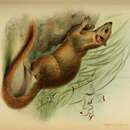en
names in breadcrumbs


Perception Channels: tactile ; chemical
IUCN Red List of Threatened Species: least concern
None known
Prior to being classified in their own order, Scandentia, tree shrews were placed either in the Order Insectivora or in the Order Primates. Considered primitive primates, they were popular experimental subjects in neurobiology and neuroanatomy. Tree shrews were "considered ideal subjects to gain insight into the organization of the early primate visual system" (German Primate Center). Anathana ellioti, rare in the wild and in captivity, is of no economic importance to humans (Chorazyna and Kurup 1975).
Positive Impacts: research and education
Indian tree shrews are omnivorous. They eat insects such as caterpillars, flying ants, and butterflies as well as earthworms and fruit (such as wild berries). They have also been observed eating the fruit of Lantana camara, a common thorny shrub. Anathana ellioti only occasionally uses its hands when eating insects and fruit. Indian tree shrews spend much of their morning and evening hours foraging for food. Foraging is always solitary (Chorazyna and Kurup 1975).
Animal Foods: insects; terrestrial worms
Plant Foods: fruit
Primary Diet: omnivore
Indian or Madras tree shrews are found on the Indian subcontinent south of the Ganges River (Roonwal and Mohnot 1977). Three subspecies are recognized according to their specific geographic range. Anathana ellioti ellioti inhabits the Eastern Ghats and the Shevaroy Hills of Southern India (Waterhouse 1850 in Roonwal and Mohnot 1977). Anathana ellioti pallida is found in Central India primarily in Madhya Pradesh and Raipur northwest of the Ganges River (Lyon 1913 in Roonwal and Mohnot 1977), and Anathana ellioti wroughtoni lives in Western India in the Satpura Range and the Dangs near Bombay (Lyon 1913 in Roonwal and Mohnot 1977).
Biogeographic Regions: oriental (Native )
Indian tree shrews have been sighted in moist to semi-moist deciduous forests in an overall dry deciduous area (Shrivastava 1994). They have also been observed on stone covered slopes and ravines, some near cultivated fields and pastures (Chorazyna and Kurup 1975; Shrivastava 1994).
Habitat Regions: tropical
Terrestrial Biomes: forest
Anathana ellioti resembles Tupaia in appearance but has larger ears with thicker hair than does Tupaia. Indian tree shrews' upper parts are speckled with brown, yellow, and black often with a reddish tinge (Nowak 1997). The ventral portion is nearly white as is an oblique shoulder stripe (Roonwal and Mohnot 1977). Body and head length range from 16.0cm to 18.5cm and tail length ranges from 16.5cm to 19.5cm. The dilambdodont dentition of A. ellioti reflects its omnivorous feeding habits. The dental formula is 2/3 1/1 3/3 3/3 = 9/10 (Verma 1965).
Average mass: 160 g.
Other Physical Features: endothermic ; bilateral symmetry
Not primarily arboreal mammals, Indian tree shrews have been known to climb trees rapidly when alarmed or frightened (Chorazyna and Kurup 1975; Shrivastava 1995). This is likely an adaptation to escape predation.
Little is known of the reproductive behavior of A. ellioti. According to the anatomy of its reproductive system, five young may be produced at a time (Verma 1965). In contrast to Tupaia in which the male testes are scrotal, the testes are abdominal in A. ellioti (Verma 1965; Hayssen 1993).
Range number of offspring: 1 to 5.
Key Reproductive Features: gonochoric/gonochoristic/dioecious (sexes separate); sexual ; fertilization (Internal ); viviparous
The Madras treeshrew (Anathana ellioti), also known as the Indian treeshrew, is a species of treeshrew in the monotypic genus Anathana found in the hill forests of central and southern India. The genus name is derived from the Tamil name of moongil anathaan (literally "bamboo squirrel") and the species name is after Sir Walter Elliot of the Indian Civil Services in Madras.

This treeshrew is 16.0 to 18.5 cm long with a tail of 16.5 to 19.5 cm. The nominate race (type locality: Eastern Ghats, Madras. British Museum 50.1.21.5) has the tail coloured like the back, the ground colour above being reddish-brown while the feet and hind legs are buff or ochraceous. The other two races have the tail coloured differently from the back. The race A. e. pallida (type locality: Manbhum, Bengal, collected by Robert Cecil Beavan British Museum 66.12.28.2) has the colour of body above reddish-brown and the feet and hind legs grizzled buffy. Race A. e. wroughtoni (type locality: Mandvi, Surat, collected by R. C. Wroughton British Museum 96.11.7.1) has the colour of body above dull grizzled brownish and the feet and hind legs grizzled greyish.[5] Some later workers lump all the three races.[6]
Its dental formula is 2.1.3.33.1.3.3 × 2 = 38. The dentition is suited for an omnivorous diet.[7]
Some authors have suggested this species could be included within the genus Tupaia, although most have kept the genus separate based on anatomical differences.[8]
The Madras treeshrew is found on the Indian Subcontinent south of the Ganges River. Three subspecies have been described — A. e. ellioti of the Eastern Ghats, Biligirirangan[9] and the Shevaroy Hills and other hills of Southern India, A. e. pallida from Central India primarily in Madhya Pradesh and Raipur, and A. e. wroughtoni from the Satpura Range and the Dangs near Bombay. They have been reported within the Western Ghats ranges of Wayanad (Periya)[10] and Mahabaleshwar. The northernmost record is from Garhwa district of Bihar.[11] Little is known about the status of these populations as the distribution is patchy, but S. M. Mohnot considered them as "common" in 1975.[12]

This species of treeshrew is not particularly arboreal and spends much of its time on the ground or clambering about on rocky terrain in the search of insects and seeds.[14] It is easily separated from the squirrels in the field by the shape and color of the tail and the upward curve in which it is held when walking about.
They have a behaviour of climbing up low, slanting trunks and sliding down headfirst.[15] This may be associated with scent marking, as many of the Scandentia have scent glands on their throats.
A species of sucking louse Docophthirus acinetus is found only on this species, the genus itself being restricted to hosts in the family Tupaiidae.[16] Endoparasitic microfiliriae have also been described from the species.[17] The Crested Hawk-eagle (Nisaetus cirrhatus) has been known to prey on this tree shrew.[18]
{{cite web}}: External link in |work=The Madras treeshrew (Anathana ellioti), also known as the Indian treeshrew, is a species of treeshrew in the monotypic genus Anathana found in the hill forests of central and southern India. The genus name is derived from the Tamil name of moongil anathaan (literally "bamboo squirrel") and the species name is after Sir Walter Elliot of the Indian Civil Services in Madras.